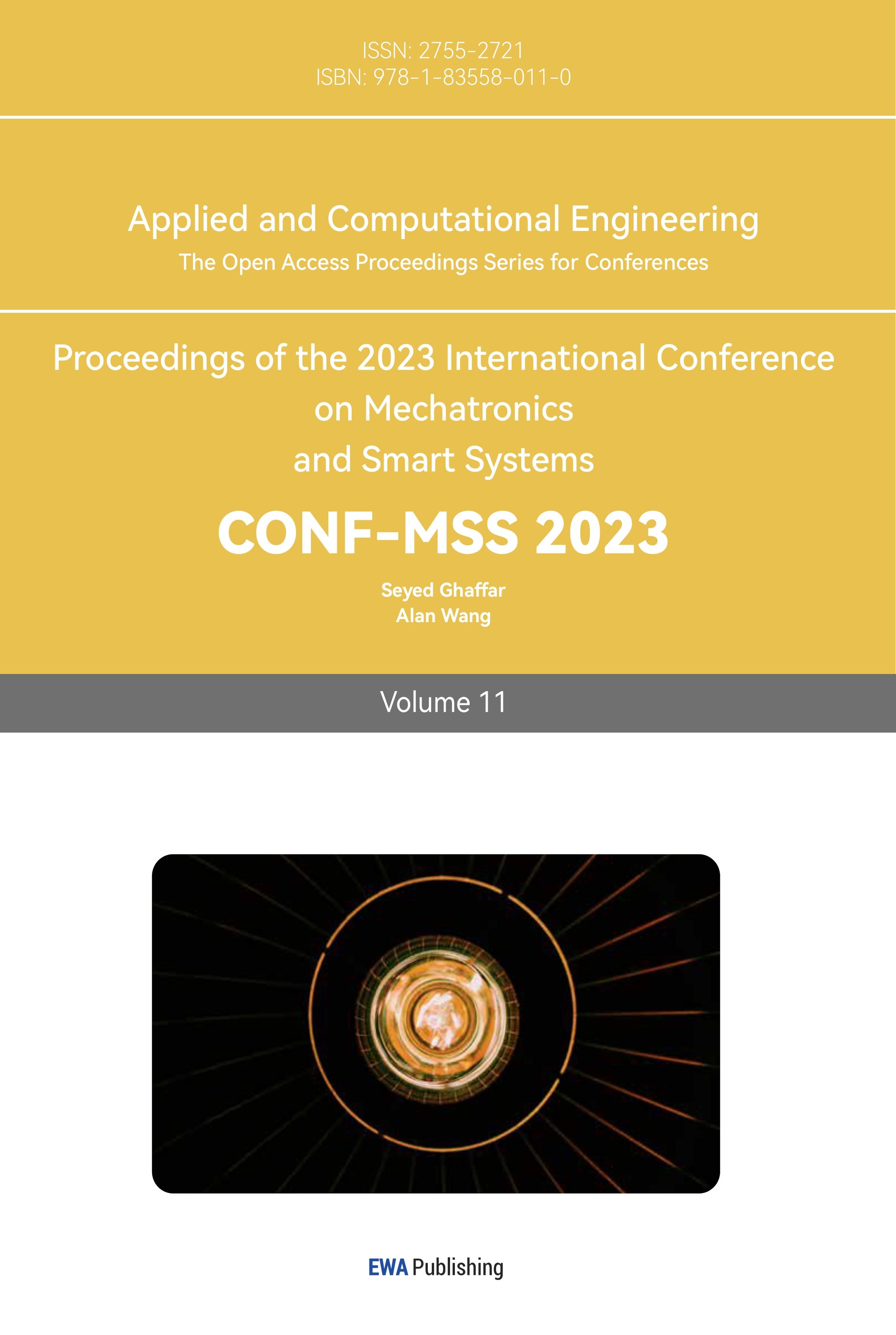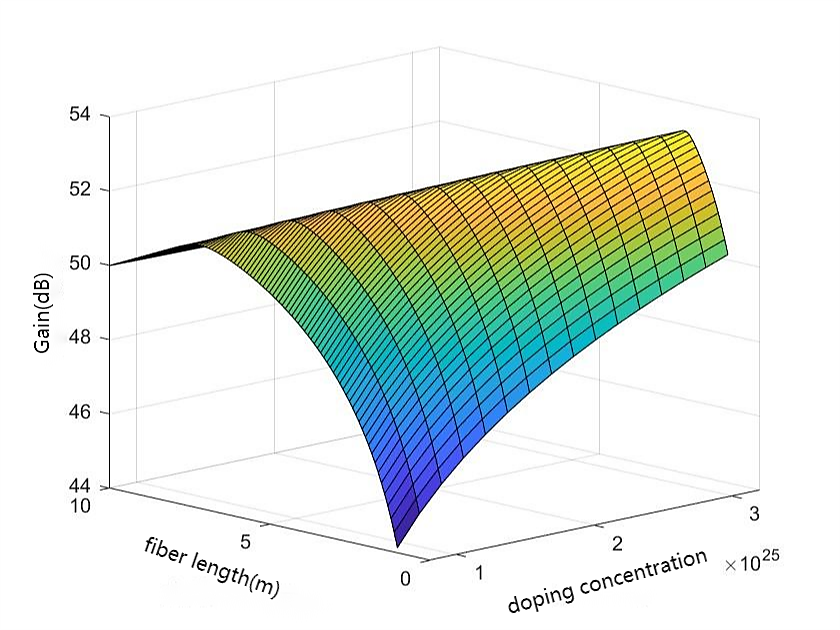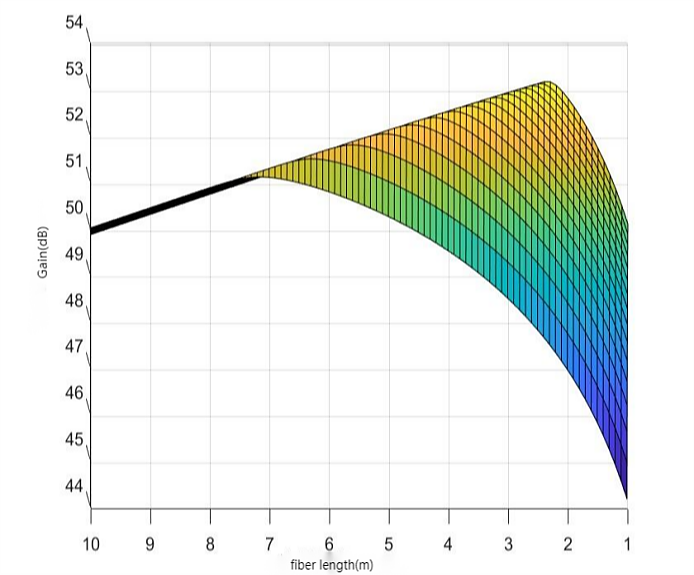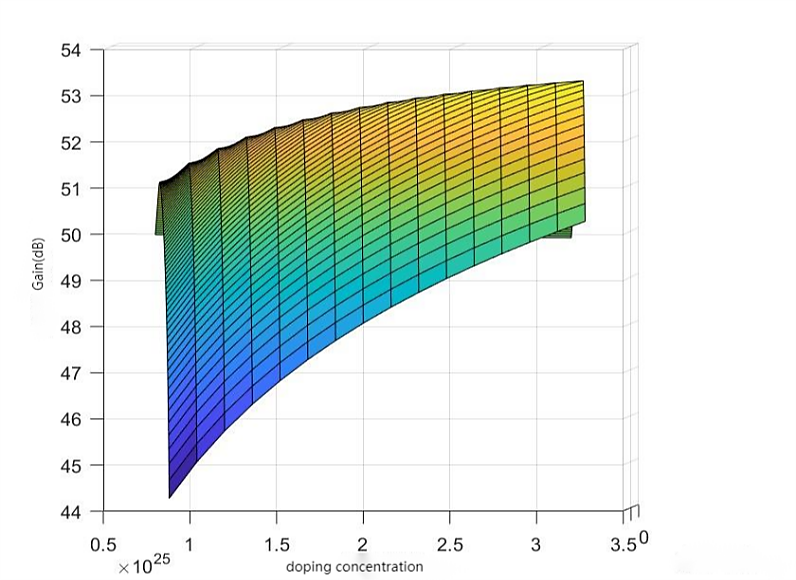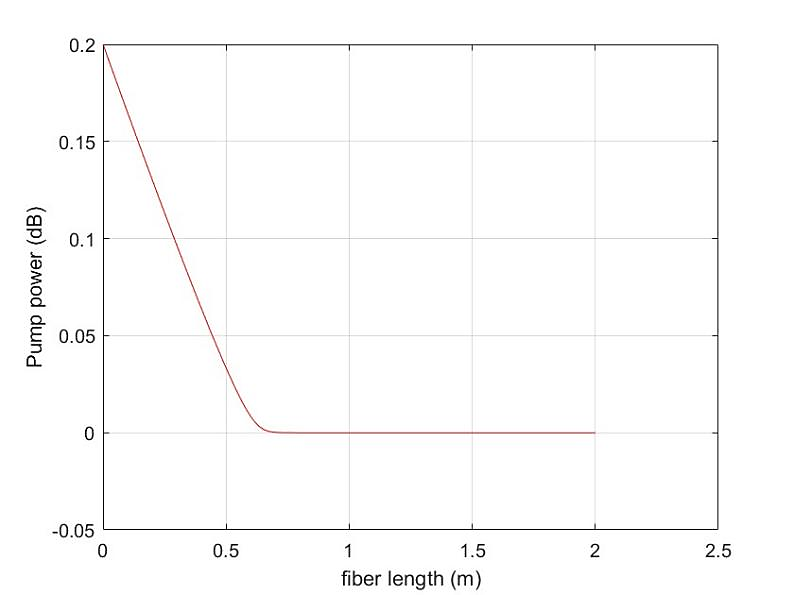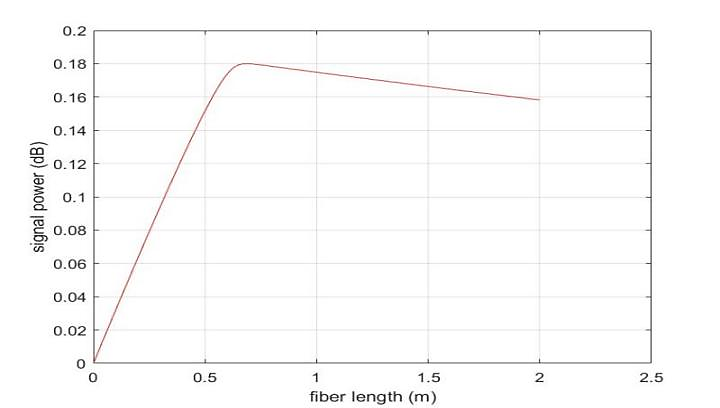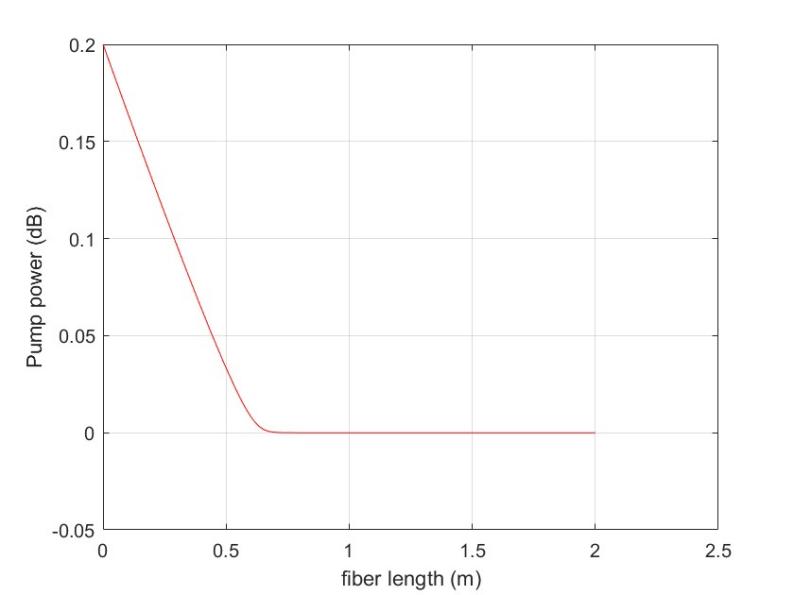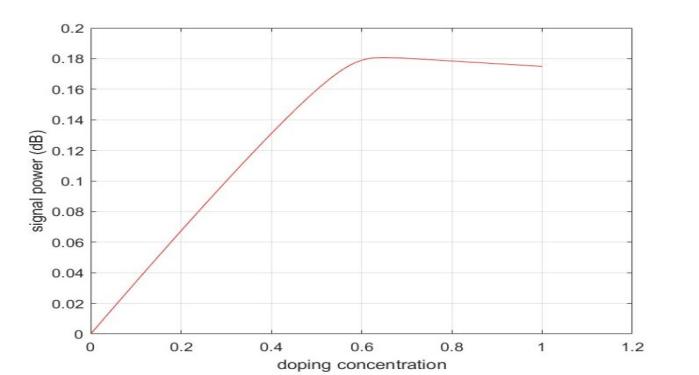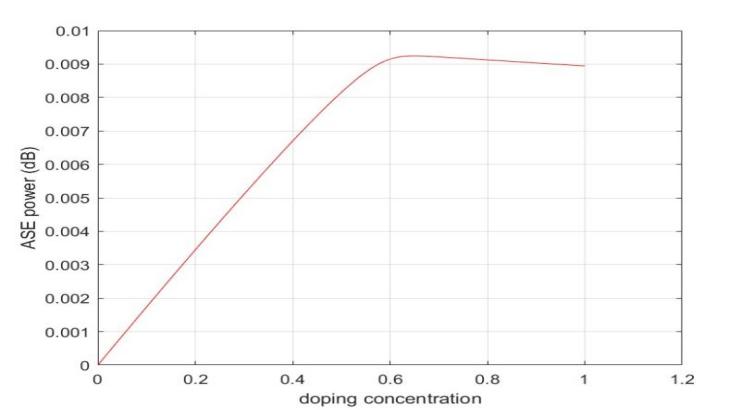1. Introduction
Fiber amplifiers are used more at 1500-1600 nm, but the band has become saturated due to surging demand. Therefore, we need to expand the new bands to join the research application [1]. The first laser was a neodymium-doped ion laser, which was invented in 1961. The laser uses a 300-micron diameter, one-metre length core as a gain medium, resulting in a laser with a wavelength of 1.06 microns [2]. Metropolis et al. first proposed the simulated annealing algorithm in 1953. In 1983, simulated annealing was first introduced into combinatorial optimization. The idea of introducing simulated annealing into combinatorial optimization was first proposed by S. Kirkpatrick et al. High initial temperature is needed as a perquisite for the starting of the stimulated annealing algorithm. In addition, probabilistic jump characteristics need to be combined. That is, search randomly in the solution space until the global optimal solution is found [3]. Neodymium-doped optical fiber refers to the optical fiber mixed with neodymium (Nd3+) ions in the fiber core. After absorbing the pump light, the neodymium-doped optical fiber achieves light amplification through the stimulated radiation. It is mainly used in neodymium-doped fiber laser and fiber amplifiers, the human eye safety wavelength industry, and medical fields. The purpose of this study is to write a simulated annealing algorithm by matlab, and use its characteristics to find the Nd3+ doped fiber amplifier at 1250-1350 nm fiber length and doping concentration on its gain, and at the same time to find the maximum gain under this action. It is found that the gain of the fiber amplifier is larger under certain fiber length and doping concentration. This paper provides a new way to use fiber amplifier to transmit fiber in 1250-1350 nm band to alleviate the problem of saturation of EDFA band transmitted by fiber.
2. Basic principle
2.1. Principle of optical fiber amplifier
Optical Fiber Amplifier (OFA):It can amplify the signal, and people can use it in communication lines, doping optical fiber as the gain medium [4].
Optical fiber amplifier technology is the incorporation of rare earth elements that can produce laser into the optical fiber core and the laser can provide the amplification of the light signal through the DC light excitation. The traditional transmission system uses a repeater, the way light is converted into electricity and back again. System stability and reliability can be affected by relays. To remove the above conversion process and let the signal be amplified and transmitted directly on the optical path, it is indispensable to use an all-optical transmission repeater to replace this regenerative repeater.
2.2. Nd-doped optical fiber optic amplifier
The first fiber laser developed is the doped Nd3+ fiber laser. Still, the mature development is a ytterbium-doped fiber laser. Because people found that ytterbium ions are more likely to produce laser oscillation. However, in the past 20 years, there is considerable research on doped Nd3+ fiber laser at home and abroad. Foreign research is more advanced and mature [5].
Neodymium doped fiber amplifier with excited solid-state absorption at 1300 nm band limits its application in 1300 nm band communication, a compact and durable Nd: YAG laser source pumped by a semiconductor laser can be supplied by a neodymium-doped fiber amplifier in the 1064 nm band [6]. It does not have as a severe stimulated absorption phenomenon as an erbium-doped fiber amplifier, which can reach the limit of quantum noise coefficient. This is because the inner cladding is hundreds of times larger than the single-mode core area, which is suitable for a large area of laser diode pumping, to get the output of a high-power signal. However, the cladding diameter of an erbium-doped and an Ytterbium-doped fiber amplifiers can only be several times larger than that of the single-mode core region. In addition, Neodymium-doped fiber amplifiers have many advantages, such as low pump threshold and low noise factor. So, it has been widely used in space communication and high-power amplification over the years [7].
2.3. Principle of the simulated annealing algorithm (SA)
Metropolis et al. deduced the SA based on solid annealing. It's a probabilistic algorithm. First heat the solid to high temperature, then let it gradually cool. When people heat a solid, the particles inside the solid gradually become disordered as the temperature increases, the internal energy increases, and particles like molecules and atoms become unstable. In the process of solid cooling, molecules and atoms gradually return to order, internal energy decreases, and particles stabilize. Finally, the ground state is reached at room temperature and the internal energy is minimized.
According to the Metropolis criterion, the expression e^(-ΔE/(kT)) is the probability at room temperature T for the particles tend to the equequilibrium, the E represents the internal energy, ∆E is the change of energy, k is the Boltzmann function. For simulating the problem of combined optimization with solid annealing, the value of the objective function f is used to control E and the control parameter t is used to control T. Then people get SA, and people use SA to solve the combinatorial optimization problem.: Starting from the control parameter t and the initial solution i, and then iterating repeatedly for the current solution "generating a new solution to calculate the functional difference of the objective to acceptance or discard", and gradually reduce the t value. When the algorithm terminates, the obtained solution is the closest to the optimal solution. This heuristic random search process is realized by Monte Carlo iteration [8].
3. Theory model
3.1. Energy level system situation of Nd3+ ions at 1,300 nm
The typical output bands of the solid laser doped Nd3+: YAG are 1064 nm and 1319 nm bands belonging to the four-level transition and the 946 nm band belonging to the quasi-four-level change, Quasi-four-level changes have the same upper energy level. According to the literature, the ESA process of Nd3+ at 1300 nm is a four-level system. The 4I9/2 level can be regarded as the ground state level. In the 800 nm pump, light transfers the electron on 4I9/2 to the 4F5/2 excited state (which can be regarded as the fourth excited state), then rapidly to the 4F3/2 level (as the third excited state). The light between 1300 and 1400 nm is radiated between 4F3/2 and 4I3/2, and finally returns to 4I9/2 (ground state) with the non-radiative transition, as shown in Figure 1 [9].
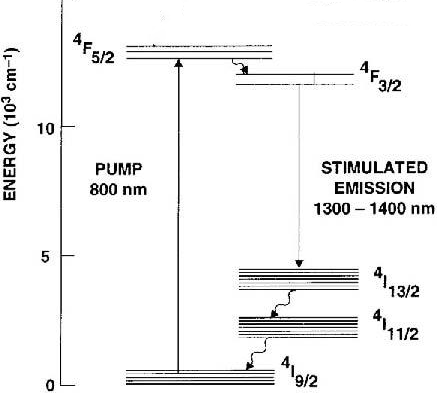
Figure 1. Illustration of ESA process at 1300 nm for Nd3+ [9].
3.2. The rate equations and the power equations for the four-level system and the gain equation
The Rate equation are:
\( \frac{∂{N_{1}}(z)}{∂t}=-{W_{p}}(z){N_{1}}(z)+{A_{21}}{N_{2}}(z) \) (1)
\( \frac{∂{N_{2}}(z)}{∂t}=-{A_{21}}{N_{2}}(z)-{W_{23}}(z){N_{2}}(z)+{W_{32}}(z){N_{3}}(z)+{A_{32}}{N_{3}}(z) \) (2)
\( \frac{∂{N_{3}}(z)}{∂t}={W_{23}}(z){N_{2}}(z)-{W_{32}}(z){N_{3}}(z)-{A_{32}}{N_{3}}(z)+{A_{43}}{N_{4}}(z) \) (3)
\( \frac{∂{N_{4}}(z)}{∂t}={W_{p}}(z){N_{1}}(z)-{A_{43}}{N_{4}}(z) \) (4)
\( N={N_{1}}(z)+{N_{2}}(z)+{N_{3}}(z)+{N_{4}}(z) \) (5)
Power equations are:
\( \frac{d{P_{p}}(z)}{dz}=\Gamma _{p}(-{σ_{p}}{N_{1}}(z)-{α_{a}}){P_{p}}(z) \) (6)
\( \frac{d{P_{s}}(z)}{dz}=\Gamma _{s}[{σ_{32}}{N_{3}}(z)-{σ_{23}}{N_{2}}(z)-{α_{s}}]{P_{s}}(z) \) (7)
\( \frac{d{P_{ase}}(z)}{dz}=\Gamma _{ase}[{σ_{32}}{N_{3}}(z)-{σ_{23}}{N_{2}}(z)-{α_{s}}]{P_{s}}(z)+{σ_{32}}{N_{3}}(z)hvΔv \) (8)
The purpose of this paper is to study the maximum gain of the doped Nd3+ fiber amplifier at 1250-1350 nm, so the parameters required for the gain equation are obtained from the four-level system rate equation, and the power equation, and the gain equation is constructed to calculate the maximum power.
Gain equations are:
\( G({P_{p}}(z),{P_{s}}(z),{N_{2}},{N_{1}},z)=\frac{{P_{s}}(z)}{{P_{s}}(0)}(100\%) \) (9)
\( G({P_{p}}(z),{P_{s}}(z),{N_{2}},{N_{1}},z)=10*log{10(\frac{{P_{s}}(z)}{{P_{s}}(0)})}(dB) \) (10)
The respective parameters are shown in Table 1.
Table 1. Transition probability of spontaneous radiation [10].
Spontaneous emission rate of each energy level | Value of the coefficient (W/(㎡*K⁴)) |
A43 | 2000.0 |
A32 | 543.66 |
A21 | 2079.47 |
3.3. Matlab for modeling
Matlab modeling is used to construct rate equation, power equation, and gain equation, and combine the three through editing scripts to control the fiber length change and doping concentration to find the maximum power.
The simulated annealing optimization algorithm is found in Matlab, the gain equation is connected to the simulated annealing (SA), and the SA is used to find the gain maximum value.
4. Results and discussion
4.1. Matlab modeling optimization gain with fiber length and doping concentration
The profit varies with the length of fiber and the particle concentration, as shown in Figure 2(a). It can be roughly observed that when the length of fiber is cut, the gain is increased. The profit enlarges with increasing doping concentration,to reach a maximum at the upper right corner.
|
|
|
(a) | (b) | (c) |
Figure 2. A 3D stereo diagram of the gain change with the fiber length and the doping concentration. | ||
The effect of the fiber length or doping on the gain is next observed unilaterally. First, look at the effect of the length of fiber on the gain. The income increases with the fiber length at 1-3 m, and when the fiber length is 3-10 m, as shown in Figure 2(b). Secondly, the effect of doping concentration on the growth. As the doping concentration increases, the gain increases gradually, as shown in Figure 2(c). When the combination of the two has effects on the growth, the maximum profit is obtained when the fiber length is 2.4 m, and the Nd3+ concentration is 3.2*(10^25). The maximum profit is: 53.2182dB.
4.2. Using a simulated annealing algorithm to optimize the parameters
4.2.1. Gain varies with the fiber length. The gain increases with the increase of the fiber length, the maximum value is 52.6742dB; as shown in Figure 5; the pump gain decreases with the fiber length, the maximum value is 0.2dB, as shown in Figure 6; the signal optical gain increases first and then decreases, the maximum value is 0.18dB, Figure 7; the ASE gain increases and then decreases with the increase of the fiber length, the peak value is 0.0093dB, as shown in Figure 8.
|
|
Figure 5. Simulates the degradation algorithm by calculating the gain varying with the fiber length. | Figure 6. Simulates the degradation algorithm to calculate the pump light gain changing with the fiber length. |
|
|
Figure 7. Simulates the degradation algorithm to calculate the signal light gain changing with the fiber length. | Figure 8. Simulated degradation algorithm calculating ASE gain with fiber length. |
4.2.2. Gain varies with the doping concentration. The gain increases with the doping concentration. Figure 9 shows the maximum value is 52.7505dB. Figure 10 shows the pump light gain decreases when the doping concentration is 0.2dB, as shown. Figure 11 shows the signal light gain increases, and the maximum value is 0.188639dB. Figure 12 shows the ASE gain increases with the doping concentration, and the peak value is 0.00949427dB.
|
|
Figure 9. Simulates the degradation algorithm by calculating the gain change with the doping concentration. | Figure 10. Simulates a degradation algorithm for calculating the pump light gain varying with the doping concentration. |
|
|
Figure 11. A simulated degradation algorithm is calculating the signal light gain with doping concentration. | Figure 12. Simulated degradation algorithm is calculating ASE gain with doping concentration. |
5. Conclusion
In this paper, we first obtained the relationship between the gain and the fiber length, and the doping concentration according to the Matlab modeling editing script. The paper found that the neodymium-doped fiber amplifier at the central wavelength is 1300 nm and the fiber length is 2.4m and the doping concentration is 3.2*(10^25). The maximum profit is 53.2182dB. The relationship between gain and fiber length or doping concentration is also found in this study, which is conducive to the subsequent study of the influence of single change on the gain of fiber amplifier. The theory demonstrates the feasibility of a neodymium-doped fiber amplifier in the 1250-1350 nm band, as well as its full power secondly, the influence of the length of fiber and doping concentration. When the length is 3.42 m, the profit is the maximum, and the maximum profit is 52.6742dB. When the Nd3+ concentration is 3.5*10^25, the gain is the maximum and the maximum gain is 52.7505dB. However, due to the function script construction problem, the simulated annealing algorithm only unilaterally calculates the gain about the fiber length and the doping concentration. There is no specific common effect on the gain and the neodymium-doped fiber amplifier has strong excited absorption at 1300 nm band, which limits its application in 1300 nm band communication Therefore, subsequent experiments are needed to overcome the problems to realize the application of neodymium-doped fiber amplifier in 1250-1350 nm band.
References
[1]. Chang J 2006 Study on light amplification in a rare-earth-doped optical fiber amplifier Shandong University
[2]. Wang C 2010 Noddmium green fiber laser Northwest University
[3]. Steinbrunn M, Moerkotte G and Kemper A 1997 Heuristic and Randomized Optimization or the Join Ordering Problem J. VLDB. 6(3) p 8-17
[4]. Liu J L, Wang W C, Xiao Y B, Huang S J, Mao L Y and Zhang Q Y 2019 Nd3+-doped TeO2-MoO3-ZnO tellurite glass for a diode-pump 1.06 μm laser. J. Non-Crystalline Solids 506 pp 32-38 doi: 10.1016/j.jnoncrysol.2018.11.030.
[5]. Yang L P 2012 Experimental study on neodymium-doped double-coated fiber laser and its cavity frequency doubling frequency Northwest University
[6]. Kong Y, Guo M X and Lu Y T 2004 Analysis of the nonlinear refractive index of a neodymium-doped fiber-optic amplifier China Laser 07 pp 789-792
[7]. Cao D X, He S B and Zheng W G 2005 Progress in a neodymium-doped inorganic liquid laser J. Prog Laser Light Optoelectron. pp 17-21
[8]. Chen H B 2013 Solving the TSP problem based on a multiple population simulated annealing algorithm Wuyi University
[9]. Miniscalco W 2001 Optical and Electronic Properties of Rare Earth Ions in Glasses
[10]. Poker M 2012 Comparative studies of the spectroscopic properties of Nd^3+: YAG nanocrystals, transparent ceramic and single crystal. Opt. Materials Exp. 2 p 235-249
Cite this article
Wang,J. (2023). The simulated annealing algorithm was used to find the maximum gain of a Nd-doped fiber amplifier between 1350-1350nm. Applied and Computational Engineering,11,52-58.
Data availability
The datasets used and/or analyzed during the current study will be available from the authors upon reasonable request.
Disclaimer/Publisher's Note
The statements, opinions and data contained in all publications are solely those of the individual author(s) and contributor(s) and not of EWA Publishing and/or the editor(s). EWA Publishing and/or the editor(s) disclaim responsibility for any injury to people or property resulting from any ideas, methods, instructions or products referred to in the content.
About volume
Volume title: Proceedings of the 2023 International Conference on Mechatronics and Smart Systems
© 2024 by the author(s). Licensee EWA Publishing, Oxford, UK. This article is an open access article distributed under the terms and
conditions of the Creative Commons Attribution (CC BY) license. Authors who
publish this series agree to the following terms:
1. Authors retain copyright and grant the series right of first publication with the work simultaneously licensed under a Creative Commons
Attribution License that allows others to share the work with an acknowledgment of the work's authorship and initial publication in this
series.
2. Authors are able to enter into separate, additional contractual arrangements for the non-exclusive distribution of the series's published
version of the work (e.g., post it to an institutional repository or publish it in a book), with an acknowledgment of its initial
publication in this series.
3. Authors are permitted and encouraged to post their work online (e.g., in institutional repositories or on their website) prior to and
during the submission process, as it can lead to productive exchanges, as well as earlier and greater citation of published work (See
Open access policy for details).
References
[1]. Chang J 2006 Study on light amplification in a rare-earth-doped optical fiber amplifier Shandong University
[2]. Wang C 2010 Noddmium green fiber laser Northwest University
[3]. Steinbrunn M, Moerkotte G and Kemper A 1997 Heuristic and Randomized Optimization or the Join Ordering Problem J. VLDB. 6(3) p 8-17
[4]. Liu J L, Wang W C, Xiao Y B, Huang S J, Mao L Y and Zhang Q Y 2019 Nd3+-doped TeO2-MoO3-ZnO tellurite glass for a diode-pump 1.06 μm laser. J. Non-Crystalline Solids 506 pp 32-38 doi: 10.1016/j.jnoncrysol.2018.11.030.
[5]. Yang L P 2012 Experimental study on neodymium-doped double-coated fiber laser and its cavity frequency doubling frequency Northwest University
[6]. Kong Y, Guo M X and Lu Y T 2004 Analysis of the nonlinear refractive index of a neodymium-doped fiber-optic amplifier China Laser 07 pp 789-792
[7]. Cao D X, He S B and Zheng W G 2005 Progress in a neodymium-doped inorganic liquid laser J. Prog Laser Light Optoelectron. pp 17-21
[8]. Chen H B 2013 Solving the TSP problem based on a multiple population simulated annealing algorithm Wuyi University
[9]. Miniscalco W 2001 Optical and Electronic Properties of Rare Earth Ions in Glasses
[10]. Poker M 2012 Comparative studies of the spectroscopic properties of Nd^3+: YAG nanocrystals, transparent ceramic and single crystal. Opt. Materials Exp. 2 p 235-249





